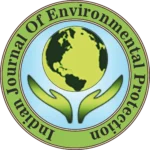IJEP 44(3): 273-281 : Vol. 44 Issue. 3 (March 2024)
Usha Subburaj*, Piranavpathy E.K., Saravana Pandian S. and Shridar P.
Mepco Schlenk Engineering College, Department of Civil Engineering, Sivakasi – 626 005, Tamil Nadu, India
Abstract
In 21st century, water pollution due to textile dye industry has turned into a severe problem around the world including India. The dye industry in India is made-up of about 85 large organized units and 4,000 small scale units, they produce around 1,60,000 tonnes of dyestuff per month. These direct discharges of dye wastewater effluent into waterbodies, like lakes, rivers and others, affect plants and animals. The aim of our research is to prepare activated carbon from coconut shell with surface modification through chemical activation method. Adsorption of Allura Red dye was done using both pellet and powder form of activated carbon at different contact times. The effects of contact time, powdered activated carbon and chitosan dosage and speed on adsorption efficiency was studied. The maximum removal efficiency of 96.73% was achieved at optimum contact time of 90 min with the ratio of 2:1:1 of chemically activated carbon, chitosan and dye wastewater. Adsorption kinetics were also studied and it followed the second order kinetics. The effect of dyes when it is discharged into natural waterbodies was studied.
Keywords
Allura Red dye, Activated coconut shell, Adsorption
References
- Gomez, V., M.S. Larrechi and M.P. Callao. 2007. Kinetic and adsorption study of acid dye removal using activated carbon. Chemosphere. 69(7): 1151-1158.
- Crini, G. and P.M. Badot. 2008. Application of chitosan, a natural amino polysacharide for dye removal from aqueous solutions by adsorption processes using batch studies: A review of recent literature. Progress Polymer Sci., 33(4): 399-
447. - Vakili, M., et al. 2014. Application of chitosan and its derivatives as adsorbents for dye removal from water and wastewater: A review. Carbohydrate Polymers. 113: 115-130.
- Mahmoodi, N.N., et al. 2011. Dye removal from coloured textile wastewater using chitosan in binary systems. Desalination. 267(1): 64-72.
- Ihsanullah, I., M. Bilal and A. Jamal. 2022. Recent developments in the removal of dyes from water by strack based adsorbents. Chem. Record. 22(7): e202100312.
- Albishri, W.S. and H.A. Katouah. 2023. Functiona-lization of sodium magnesium silicate hydroxide/sodium magnesium silicate hydrate nonostructures by chitosan as a novel nanocomposite for efficient removal of methylene blue and Crystal Violet dyes from aqueous media. Arabian J. Chem., 16(7).
- Zhao, C., et al. 2023. Preparation and performance of coal based activated carbon based on an orthogonal experimental study. Energy. 274: 127353.
- Wang, X., et al. 2023. Archeiving multi-cycle regeneration of activated carbon and Cr (VI) removal over a wide pH range by hydrothermal converting quinonimine dye into difunctional pyrolic-N: Implication for carbon capture in printing and dyeing wastewater treatment. Chem. Eng. J., 459: 141646.
- Mu, Z., et al. 2022. Insight into the highly efficient adsorption towards cationic methylene blue dye with a super absorbent polymer modified by esteri-fied starch. J. Env. Chem. Eng., 10(5): 108425.
- Yantus, A.B., et al. 2023. Potential of activated carbon from various sources as a low-cost adsorbent to removed heavy metals and synthetic dyes. Results Chem., 5(1–3): 100711.
- Rao, V.S. and S.R.M. Rao. 2006. Adsorption studies on treatment of textile dyeing industrial effluent by flyash. Chem. Eng. J., 116(1): 77-84.
- Al-Ghouti, M.A. and A.O. Swleh. 2019. Optimizing textile dye removal by activated carbon prepared from olive stones. Env. Tech. Innov., 16: 100488.
- Amaya, A., et al. 2015. Preparation of charcoal pellets from eucalyptus wood with different binders. J. Energy Natural Resour., 4(42): 34-39.
- Subramani, S.E. and N. Thinakaran. 2017. Isotherm, kinetic and thermodynamic studies on the adsorption behaviour of textile dyes onto chitosan. Process Safety Env. Prot., 106: 1-10.
- Duran-Jimenez, G., et al. 2019. Fast regeneration of activated carbon saturated with textile dyes: Textural, thermal and dielectric characterization. Chem. Eng. J., 378: 121774.
- Dolas, Hacer. 2023. Activated carbon synthesis and Methylene Blue adsorption from pepper stem using microwave assisted impregnation method: Isotherm and kinetics. J. King Saud University Sci., 35(3): 102559.
- Evans, J. and P.T. Williams. 2000. Metal adsorption onto flyash in waste incineration flue gases. Process Safety Env. Prot., 78(1): 40-46.
- De Freitas, F.P., et al. 2021. Adsorption of neutral red dye by chitosan and activated carbon composite films. Heliyon. 7(7): e07629.
- Al-Samman, M.T. and J. Sanchez. 2021. Recent advances on hydrogens based on chitosan and alginate for the adsorption of dyes and metal ions from water. Arabian J. Chem., 14(12): 103455.
- Qamar, S.A., et al. 2020. Chitosan-based hybrid materials as adsorbents for textile dyes: A review. Case Studies Chem. Env. Eng., 2: 100021.
- Partlan, E., et al. 2020. Adsorption kinetics of synthetic organic contaminants onto superfine powdered activated carbon. Chemosphere. 253: 126628.
- Paredes-Laverde, M., et al. 2021. Understanding the removal of an anionic dye in textile wastewater by adsorption on ZnCl2activated carbons from rice and coffee husk wastes: A combined experimental and theoretical study. J. Env. Chem. Eng., 9(4): 105685.
- Kavitha, G., et al. 2021. Dye removal kinetics and adsorption studies of activated carbon derived from the stems of Phyllanthus reticulatus. Mater. Today Proceedings. 45(9): 7934-7938.
- Pelaez-Cid, A., et al. 2020. Synthesis of activated carbons from black sapote seeds, characterization and application in the elimination of heavy metals and textile dyes. Chinese J. Chem. Eng., 28(2): 613-623.
- Hoque, M., O.M. Mozammel and S.C. Bhattacharya. 2002. Activated charcoal from coconut shell using ZnCl2activation. Biomass Bioenergy. 22(5): 397-400.
